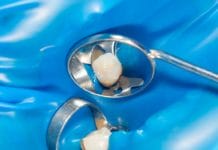Many factors play a role in the manifestation of periodontal disease. One example is stress − the body’s mechanism of response to a stressor. Negative events or challenges may alter the body’s way of functioning.7
Chronic stress is closely linked to depression, which is defined as being one of the most common psychiatric illnesses that “can evoke emotional and physiologic reactions and is the most important modifiable risk factor for physical illnesses.”11 Together, stress and depression are associated with many systemic diseases through modification of the immune response.11
This modification affects periodontal health and demonstrates a positive relationship in terms of the incidence of periodontal disease.6
In order to manage periodontal health in patients with significant stress, their stress must be recognized as a risk factor for periodontal disease. Patients must be aware of the effects of stress on their oral health as well as methods to manage stress while working collaboratively with their hygienist, physician, and mental health expert.6
Dental hygienists should pay close attention to patients with increased stress since they may exhibit behavioral changes that affect their oral health. For example, those with increased stress may excessively consume foods that contain refined carbohydrates, which could lead to the accumulation of plaque biofilm.6 Furthermore, they may pay no heed to their brushing or interdental cleaning techniques, which adds to accumulated biofilm.8 The biofilm could eventually turn into calculus that lingers in the periodontium until the patient visits a professional for scaling. Until then, the presence of bacteria could cause excess destruction of the periodontium.
This article discusses how recent research supports controlling stress and depression by using yoga techniques, which could improve the outcome of periodontal treatment.13 Yoga has been postulated to reduce the effects of stress while improving periodontal disease treatment outcomes.
Stress
Stress can be defined as “the physiological and psychological response to events that are appraised as threatening or challenging that require adjustment.”10 Stress causes a change in host response, such as immunosuppressive effects that can increase the host’s susceptibility to disease.10 Stress also contributes to many chronic inflammatory diseases, such as rheumatoid arthritis and periodontal disease.8
Psychosocial stress affects periodontal tissues through biological mechanisms and lifestyle changes.13 An increase in stress could be brought on by factors such as the environment, major life events, daily hassles, or psychological factors, which can make people more susceptible to infection with a prolonged recovery period.6
Other effects of chronic stress are manifested through anxiety, depression, or impaired cognition.8 During periods of stress, the endocrine system releases epinephrine from the adrenal glands to the bloodstream, which increases heart rate and blood pressure while heightening metabolism. Ultimately, excessive amounts of epinephrine can cause damage to the cardiovascular system.6
Cortisol, an important glucocorticoid, can be a destructive factor that is increased in those who have stress.8 When cortisol levels are higher than usual, it “contributes to hyperglycemia, reduces bone formation, [reduces] calcium absorption from the intestine, and downregulates the synthesis of collagen.”8
Cortisol also reduces the number of pro-inflammatory cells, resulting in a decrease of function in these cells.8 This decrease in functioning contributes to the periodontium being more susceptible to infection because of an increase in inflammatory cytokines that cause rapid destruction of tissue.8 This leads to increased susceptibility to chronic systemic conditions and health impairing behaviors, such as poor oral hygiene, cigarette and alcohol consumption, altered sleep patterns, and poor nutritional intake, all of which are risk factors for periodontal disease.6
In a study conducted by Katuri, et al., all subjects had a positive association between cortisol levels and the extent of pocket depths and clinical attachment levels.8 Those with both stress and periodontal disease had a higher cortisol level than those without.8 This demonstrates that high levels of cortisol can be especially destructive in the oral cavity, causing destruction to the periodontal fibers and bone levels that contribute to periodontal disease.8
In another study, 630 subjects completed two questionnaires about their day-to-day stressors and physiological/affective responses.7 Patients were then divided into two groups, satisfied/employed/happy and unsatisfied/unemployed/unhappy. These groups were further divided by age.
Clinical examinations were then conducted on each subject, the clinicians being unaware of the results of the questionnaire to avoid bias. Clinical attachment levels were measured, and those with a probing depth ≥4 mm and CAL ≥3 mm at the same site in at least four teeth were categorized as having chronic localized periodontitis.7
The findings of this study showed that the plaque index of those who were satisfied/happy between the ages of 25-55 was good, while those who were unsatisfied/unhappy between the ages 41-70 were poor.7 Those whose plaque index was fair included those who were satisfied/happy between ages 56-70 and those who were unsatisfied/unhappy between ages 25-40.7
These findings demonstrated that those who were unsatisfied/unhappy developed more plaque. It was also found that psychological stress impacts the localized immune response to Porphyromonas gingivalis, the primary periodontal pathogen responsible for the development of periodontitis.7 Moderate periodontitis was found in the group aged 25-40 who were unsatisfied/unhappy, while severe periodontitis was found in those who were unsatisfied/unhappy and aged 40-70. Those who were satisfied/happy between ages 25-40 had mild periodontitis, while those who were older and satisfied/happy had moderate periodontitis.7 The mean plaque index and stress scores for subjects who were satisfied/happy were remarkably different from those who were unsatisfied/unhappy and demonstrated that the plaque index was dependent on the psychological status of the subjects along with their stressors.7
Chronic stress can result in other oral manifestations or behaviors aside from periodontal disease. The American Dental Association (ADA) confirms that those with highly demanding and stressful lives have an increased incidence of aphthous ulcers.1 Bruxism is another effect of chronic stress. The Bruxism Association states, “Mental disorders, anxiety, stress, and adverse psychological factors are significantly related to tooth grinding during sleep, and it has been found that nearly 70% of bruxism occurs as a result of stress or anxiety.”14
Depression
Depression can be separated into many categories, such as disruptive mood dysregulation disorder, major depressive disorder, persistent depressive disorder, premenstrual dysphoric disorder, substance/medication-induced depressive disorder, and unspecified depressive disorder.4 Worldwide, over 350 million people are affected by depression at any given time.3 It is now known as a “feature of modern lifestyle” because of its frequent occurrence.12
Depression commonly arises from a form of loss, such as loneliness, shame, or sadness.2 This can be caused by the loss of a loved one, feelings of seclusion, loss of self-confidence, etc. It is also known to be linked with elevated cortisol levels, which causes destruction.9 This can negatively affect the body’s normal functions and thoughts. Because of normal functions being disrupted, oral care is neglected.
This is supported by a study conducted by Delgado-Angulo et al. that shows that mental disorders have physiological and behavioral precursors of caries and periodontal disease.2 There are different ways to cope with this disorder, such as medication, therapy, etc. However, not all of these are effective. They can also be very costly, which creates an obstacle for those of lower incomes. Other sources that can decrease depression are needed so that everyone can have access to care for their mental disorder.12
Depression has also been shown to be associated with poorer treatment outcomes in those with periodontitis. Depression was documented in 697 patients, and it was found that they had poor periodontal treatment outcomes after comparing their initial and 1-year post-treatment exams.15 These patients had both higher probing depths and tooth loss within this period.15
The Link Between Stress, Depression, and Oral Health
Chronic stress is closely linked to depressive disorders.15 Together, chronic stress and depression are associated with many systemic diseases.11 Epidemiologic studies have shown that chronic stress and depression “increase the risk of atherosclerotic cardiovascular disease, diabetes, and other systemic conditions.”15 Additionally, they affect the prefrontal cortex and hippocampus, which control moods, through the loss of function of these regions.15
Stress and depression have a complex relationship that is bidirectional. As one study pointed out, “Psychosocial stress can lead to depression in susceptible individuals, which, in turn, can be aggravated by depression.”15 C‐reactive protein, interleukin‐1, and interleukin‐6 are inflammatory markers that have been found to be positively associated with depression.15 Inflammatory cytokines play a role in the activation of symptoms of depression; however, antidepressant medication can hinder their effects.15
Antidepressants have specific side effects that can be destructive to the oral cavity. One negative side effect is xerostomia. Because saliva aids in cleansing the mouth and contains antibacterial material, the lack of saliva causes the host to be more susceptible to periodontal disease. Without this cleansing mechanism, bacteria are able to grow on teeth and cause destructive effects of supporting tooth structures.5 Antidepressants also cause unusual sleeping patterns. The growth hormone is reduced when the sleeping pattern is abnormal, which means that the tissue repair response is reduced as well.5
Patients with depression have more Tannerella forsythias, Porphyromonas gingivalis, and Aggregatibacter actinomycetemocomitans pathogenic bacteria than those who are not depressed.8 These bacteria are periodontal pathogens that invade the tissues and cause destruction.6 Depression further causes delayed wound healing, and the more one is depressed, the more delayed response they have.13 This can decrease the likelihood of periodontal treatment success and can keep the host in a susceptible state to infection.
The effect of antidepressants on depression was demonstrated through a study in which the serum levels of interleukin‐1beta, interleukin‐6, and tumor necrosis factor‐alpha were examined in those who had a major depressive disorder and were treated with commercial antidepressants.15 It was shown that treatment with specific serotonin reuptake inhibitors decreased depressive symptoms along with serum levels of those cytokines.15
Stress and depression are also associated with comorbidities, such as diabetes, which show high levels of systemic markers of inflammation. These can further modify the onset and progression of periodontal disease while also modifying the severity of depression.15
Many studies suggest that depression itself plays a role in the various types of destruction of the periodontium. In a cross-sectional study, those with rapidly progressing periodontitis had a higher measure of depression compared to those with chronic periodontitis as well as those with insignificant clinical attachment loss.15 A separate study showed that “women on long‐term sick leave for depression had more severe periodontitis and higher concentrations of interleukin‐6 in gingival crevicular fluid” as compared to those women who were healthy.15 In another study in Finnish residents, a positive correlation was found between depression and edentulousness, which further suggests that periods of depression can result in higher susceptibility to the destruction of the periodontium.15
As stated earlier, antidepressants are commonly used to treat depression. However, they can have adverse effects that can lead to the deterioration of the oral cavity. Yoga can be used as an alternative that provides relief from this depression while eliminating the adverse effects of the pharmacological approaches to treating depression.12 When one develops the habit of practicing yoga, depression can be improved by increasing serotonin levels, which increases the mood of the individual.8 An increased mood leads to better productivity, meaning that there are better oral hygiene practices that are followed, such as toothbrushing regularly. This leads to a decrease in plaque accumulation, as well as a decreased susceptibility to periodontal infection.8
Yoga, an Adjunctive Treatment Method
“Yoga is an ancient Indian practice being used for maintaining good health and to prevent the occurrence of many diseases.”13 It is considered to be effective in controlling psychological and physical issues since it is a “cultivation of correct attitudes and reconditioning of the neuromuscular systems.”13
After studying how stress and depression play a role in the progression of periodontitis, it can be inferred that through decreasing the high levels of cortisol that result from stress and depression, periodontal disease can also be controlled.1 Since stress and depression have been found to affect inflammatory markers as well as the progression of periodontal disease, yoga has been postulated to reduce their effects while improving the treatment outcome for the disease.13
There is no direct role of yoga on periodontal disease.13 While it is seen as an effective way to reduce periodontal disease by reducing stress and depression, this alone will not be sufficient enough to treat periodontal disease. However, results of periodontal treatment have been increased when yoga is also implemented as part of the treatment process.13
According to a study conducted by Shohani et al., 12 sessions of regular yoga practice were conducted, and the difference between the mean scores of depression and stress before and after were significant.12 Dalgas et al. “proved that the nature of yoga is controlling the mind and central nervous system and unlike any other sports, it has a moderating effect on the nervous system, the hormonal emissions, and physiological factors, and regulation of nerve impulses; therefore, it can be effective in improving depression and mental disorders.”12 This is also a cost-effective treatment for those who are unable to treat their stress or depression with medication or therapy.12
In another study, 80 patients were randomly separated into two groups.13 Patients were between the ages of 15-45 years old and had periodontal disease, more than 15 teeth, and were found to have the physical ability to do yoga daily.13 They were not suffering from any other oral diseases, systemic conditions, or mental illnesses, nor were any of them pregnant or using tobacco substances.13 Plaque index, probing depths, clinical attachment loss, bleeding on probing, and stress, using Cohen’s perceived stress questionnaire, were measured and analyzed. The stress questionnaire was used to determine the severity of stress while also correlating it to periodontal status.13
Patients in group one had standard periodontal treatment while those in group two were additionally trained in yoga practices, which included stress management techniques, for one week.13 After training, these patients practiced yoga daily for one hour, six days a week for three months. Their practices included breathing techniques, physical postures, cleansing techniques, meditation, and relaxation techniques. Each patient had to follow a certain standard sequence of these practices, and each of them also had at least one session of individualized counseling.13
After three months, both groups were reassessed, and a comparison was made between their previous plaque index, probing depths, clinical attachment loss, bleeding on probing, and stress levels.13 With regards to plaque index, those in group two who practiced yoga reduced their index 2.5 times more than those in group one who only had standard treatment.13 Additionally, the probing depths and clinical attachment loss in group two decreased more than 2.3 times as much as those in group one.13 Bleeding on probing improved 8.5 times more in those who practiced yoga than those who did not, and perceived stress levels decreased more than 7.5 times.13 Through this study, it was found that reducing stress levels through yogic practices also improved periodontal treatment outcomes.
Because of the reduction in stress caused by yoga, there are also positive treatment outcomes of periodontal disease that result in reduced severity of the disease.13 When stress levels were measured in a study by Sudhanshu et al., it was shown that the more stress was reduced, the lower the reading of pocket depths and plaque index.13 Yoga can also decrease cortisol levels.8 This means that there is an increase in the functions of non-inflammatory mediators, causing a decreased susceptibility to disease, including periodontal infections.8
Conclusion
Stress and depression are leading factors contributing to periodontal disease.10 Both produce negative hormones, such as cortisol and inflammatory agents, that cause periodontal disease. Studies over the years have shown that yoga has become a common practice to reduce stress and depression.8
Yoga has been shown to improve a patient’s systemic health and result in better healing, which means that it can have a therapeutic effect on the severity or progression of periodontal disease.8 It also decreases inflammation, which is the cause of periodontal disease.13 It can further be used as a cost-effective method of treating stress and depression, as well as reducing the negative effects of other treatment methods.12
When stress and depression are reduced, their destructive effects on the periodontium are suppressed as well. Adding yoga to reduce these effects, along with routine periodontal maintenance, has been shown to significantly reduce the severity of periodontal disease, leading to improved overall periodontal health.13

Mahwish Fecto, future RDH, is a dental hygiene student at Collin College based in McKinney, Texas. She graduated with a BS in Healthcare Studies, Cum Laude, from the University of Texas at Dallas in 2018 and is set to graduate with an Associate degree in Dental Hygiene in May 2021. In her spare time, she enjoys reading, writing, and listening to her favorite group, BTS.

Gracie Blake is a student at Collin College, pursuing her associate’s in dental hygiene. She has previously graduated from Paris Junior College with an associate degree in Allied Health. Gracie enjoys hunting, jigsaw puzzles, and raising micro pigs. After graduation, Gracie plans to move back to Paris to pursue her dental hygiene career.
Need CE? Check Out the Self-Study CE Courses from Today’s RDH!
Listen to the Today’s RDH Dental Hygiene Podcast Below:
References
- Babakhanov, A. (2016). Oral manifestations caused by stress. The Dental Assistant, 9–10. Ebscohost.
- Delgado-Angulo, E.K., Sabbah, W., Suominen, A.L., Vehkalahti, M.M., Knuuttila, M., Partonen, T., Nordblad, A., Sheiham, A., Watt, R.G., Tsakos, G. The association of depression and anxiety with dental caries and periodontal disease among Finnish adults. Community Dentistry and Oral Epidemiology. 2015; 1–10. https://doi.org/10.1111/cdoe.12179.
- de Manincor, M., Bensoussan, A., Smith, C.A., Barr, K., Schweickle, M., Donoghoe, L. L., Bourchier, S., Fahey, P. Individualized Yoga for Reducing Depression and Anxiety, and Improving Well-being: A Randomized Controlled Trial. Depression and Anxiety. 2016; 33: 816-828.
- Dumitrescu, A.L. Depression and Inflammatory Periodontal Disease Considerations – An Interdisciplinary Approach. Frontiers in Psychology. 2016; 7: 1–8. https://doi.org/http://dx.doi.org/10.3389/fpsyg.2016.00347.
- Fatima, Z., Bey, A., Azmi, S. A. Impact of antidepressants on periodontal health: A pilot study. Indian Journal of Health and Wellbeing. 2016; 7: 54–55.
- Gehrig, J.S., Shin, D.E., Willmann, D.E. (2019). Foundations of periodontics for the dental hygienist (5th ed., pp. 311–312). Wolters Kluwer.
- Jaiswal, G.R., Jaiswal, S.G. Psychological stress: Its effect on periodontal status of individuals. Journal of Dr. NTR University of Health Sciences. 2015; 4(4): 241–245. Ebscohost. https://doi.org/10.4103/2277-8632.171735.
- Katuri, K.K., Dasari, A.B., Kurapati, S., Vinnakota, N.R., Bollepalli, A.C., Dhulipalla, R. Association of yoga practice and serum cortisol levels in chronic periodontitis patients with stress-related anxiety and depression. Journal of International Society of Preventive & Community Dentistry. 2016; 6(1): 7–14. Ebscohost. https://doi.org/10.4103/2231-0762.175404.
- Naveen, G.H., Varambally, S., Thirthalli, J., Rao, M., Christopher, R., Gangadhar, B.N. Serum cortisol and BDNF in patients with major depression—Effect of yoga. International Review of Psychiatry. 2016; 28(3): 273–278. https://doi.org/10.1080/09540261.2016.1175419.
- Radeef, A.S., Faisal, G.G. Assessment of Depression, Anxiety and Stress Symptoms among Patients with Periodontal Disease. Journal of International Dental and Medical Research. 2017; 10: 260–264.
- Ramesh, A., Malaiappan, S., Prabhakar, J. Relationship between clinical depression and the types of periodontitis – a cross-sectional study. Drug Invention Today. 2018; 10(4): 659–663. Ebscohost.
- Shohani, M., Badfar, G., Nasirkandy, M.P., Kaikhavani, S., Rahmati, S., Modmeli, Y., Soleymani, A., Azami, M. The Effect of Yoga on Stress, Anxiety, and Depression in Women. International Journal of Preventive Medicine. 2018; 9(21): 1–4. https://doi.org/10.4103/ijpvm.IJPVM_242_16.
- Sudhanshu, A., Sharma, U., Vadiraja, H., Rana, R., Singhal, R. Impact of yoga on periodontal disease and stress management. International Journal of Yoga. 2017; 10(3): 121–127. Ebscohost. https://doi.org/10.4103/0973-6131.213468.
- Causes of Bruxism. (n.d.). The Bruxism Association. Retrieved from http://www.bruxism.org.uk/causes-of-bruxism.php.
- Warren, K.R., Postolache, T.T., Groer, M.E., Pinjari, O., Kelly, D.L., Reynolds, M.A. Role of chronic stress and depression in periodontal diseases. Periodontology 2000. 2014; 64(1): 127–138. Ebscohost. https://doi.org/10.1111/prd.12036.











